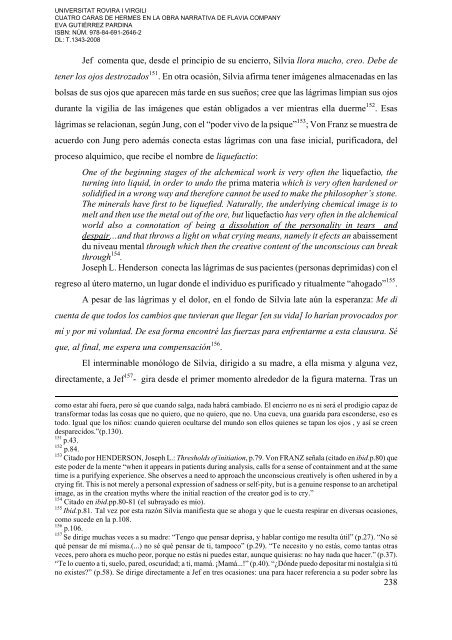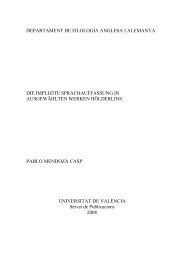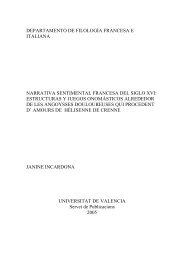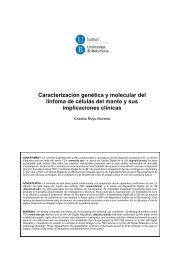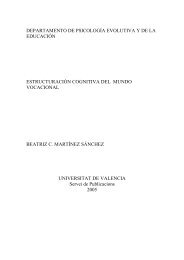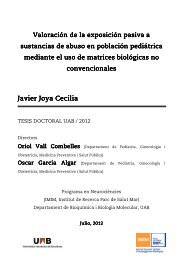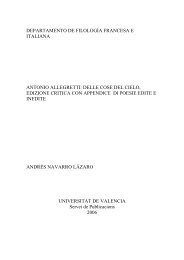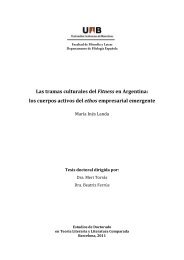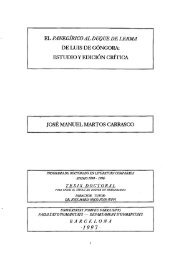Create successful ePaper yourself
Turn your PDF publications into a flip-book with our unique Google optimized e-Paper software.
UNIVERSITAT ROVIRA I VIRGILI<br />
CUATRO CARAS <strong>DE</strong> HERMES EN LA OBRA NARRATIVA <strong>DE</strong> FLAVIA COMPANY<br />
EVA GUTIÉRREZ PARDINA<br />
ISBN: NÚM. 978-84-691-2646-2<br />
DL: T.1343-2008<br />
Jef comenta que, desde el principio de su encierro, Silvia llora mucho, creo. Debe de<br />
tener los ojos destrozados 151 . En otra ocasión, Silvia afirma tener imágenes almacenadas en las<br />
bolsas de sus ojos que aparecen más tarde en sus sueños; cree que las lágrimas limpian sus ojos<br />
durante la vigilia de las imágenes que están obligados a ver mientras ella duerme 152 . Esas<br />
lágrimas se relacionan, según Jung, con el “poder vivo de la psique” 153 ; Von Franz se muestra de<br />
acuerdo con Jung pero además conecta estas lágrimas con una fase inicial, purificadora, del<br />
proceso alquímico, que recibe el nombre de liquefactio:<br />
One of the beginning stages of the alchemical work is very often the liquefactio, the<br />
turning into liquid, in order to undo the prima materia which is very often hardened or<br />
solidified in a wrong way and therefore cannot be used to make the philosopher’s stone.<br />
The minerals have first to be liquefied. Naturally, the underlying chemical image is to<br />
melt and then use the metal out of the ore, but liquefactio has very often in the alchemical<br />
world also a connotation of being a dissolution of the personality in tears and<br />
despair…and that throws a light on what crying means, namely it efects an abaissement<br />
du niveau mental through which then the creative content of the unconscious can break<br />
through 154 .<br />
Joseph L. Henderson conecta las lágrimas de sus pacientes (personas deprimidas) con el<br />
regreso al útero materno, un lugar donde el individuo es purificado y ritualmente “ahogado” 155 .<br />
A pesar de las lágrimas y el dolor, en el fondo de Silvia late aún la esperanza: Me di<br />
cuenta de que todos los cambios que tuvieran que llegar [en su vida] lo harían provocados por<br />
mí y por mi voluntad. De esa forma encontré las fuerzas para enfrentarme a esta clausura. Sé<br />
que, al final, me espera una compensación 156 .<br />
El interminable monólogo de Silvia, dirigido a su madre, a ella misma y alguna vez,<br />
directamente, a Jef 157 - gira desde el primer momento alrededor de la figura materna. Tras un<br />
como estar ahí fuera, pero sé que cuando salga, nada habrá cambiado. El encierro no es ni será el prodigio capaz de<br />
transformar todas las cosas que no quiero, que no quiero, que no. Una cueva, una guarida para esconderse, eso es<br />
todo. Igual que los niños: cuando quieren ocultarse del mundo son ellos quienes se tapan los ojos , y así se creen<br />
desparecidos.”(p.130).<br />
151 p.43.<br />
152 p.84.<br />
153 Citado por HEN<strong>DE</strong>RSON, Joseph L.: Thresholds of initiation, p.79. Von FRANZ señala (citado en ibid.p.80) que<br />
este poder de la mente “when it appears in patients during analysis, calls for a sense of containment and at the same<br />
time is a purifying experience. She observes a need to approach the unconscious creatively is often ushered in by a<br />
crying fit. This is not merely a personal expression of sadness or self-pity, but is a genuine response to an archetipal<br />
image, as in the creation myths where the initial reaction of the creator god is to cry.”<br />
154 Citado en ibid.pp.80-81 (el subrayado es mío).<br />
155 Ibid.p.81. Tal vez por esta razón Silvia manifiesta que se ahoga y que le cuesta respirar en diversas ocasiones,<br />
como sucede en la p.108.<br />
156 p.106.<br />
157 Se dirige muchas veces a su madre: “Tengo que pensar deprisa, y hablar contigo me resulta útil” (p.27). “No sé<br />
qué pensar de mí misma.(...) no sé qué pensar de ti, tampoco” (p.29). “Te necesito y no estás, como tantas otras<br />
veces, pero ahora es mucho peor, porque no estás ni puedes estar, aunque quisieras: no hay nada que hacer.” (p.37).<br />
“Te lo cuento a ti, suelo, pared, oscuridad; a ti, mamá. ¡Mamá...!” (p.40). “¿Dónde puedo depositar mi nostalgia si tú<br />
no existes?” (p.58). Se dirige directamente a Jef en tres ocasiones: una para hacer referencia a su poder sobre las<br />
238


